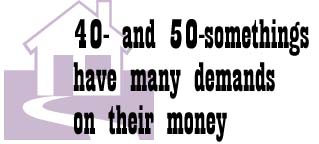|
Funds for your 40s and 50s
|
 |
Second in a three-part series on CNNfn.com May 29, 1999: 11:20 a.m. ET
Experts say investing is key because you'll get pulled from all sides financially
|
NEW YORK (CNNfn) - Getting old used to be so easy.
You retired at 62, collected a fat pension from your employer and died somewhere in your 70s.
But life is a lot more complicated these days, and financial advisors say it is even more important for people in their 40s and 50s to build a mutual fund portfolio to help their assets grow.
"People in their 40s and 50s are saving for their kids and for their retirement," said Lewis Altfest, president of L.J. Altfest & Co. in New York. " They have the most difficult time saving because they have the most overhead expenses."
Baby boomers are saddled with college tuition bills, home mortgages, auto loans, 401(k)s and IRAs, investment advisors say.
If they're in the so-called 'sandwich generation,' they are caring for aging parents. Their grown-up kids might move back home after a divorce or a job loss.
On top of all that, they may still dream about retiring early -- and they are living longer than ever.
"Ultimately, you're going to need a lot of money," said Charles Hamowy, senior financial advisor at American Express Financial Advisors in New York.

As with younger investors, financial planners say people in middle age need to map out a plan for how they'll save over time.
"The easy part is picking mutual funds," said Edward Shobe, president of The Shobe Financial Group in Baton Rouge, La. "The hard part is planning your (investing) time horizon."
Hamowy recommends baby boomers divide their cash into three portfolios. The first is for money they need immediately -- for a new car, tuition, an addition on the house. He would put that cash into a low-risk money market fund that they can access at any time.
The second pile is for 'intermediate' money they don't need for five years, which can go into the stock market, Hamowy said.
The last chunk of money is for retirement accounts. But if you want to retire early, you'll need a fourth portfolio that's not sheltered from taxes so you can tap into it before you turn 59-1/2.
Assuming you live a moderate lifestyle, you should have roughly $200,000 in your retirement accounts at this age, Hamowy said. If you're below that amount, you should try to step up your contributions. If you're far above that, you might not want to lock up a lot more cash in an account you cannot touch right away.

William Kovacic, president of Kovacic Financial Associates in Palos Heights, Ill., has a slightly different strategy for education savings. He would open a separate account for each child and allocate the money more aggressively depending on the length of time before the child packs his bags.
For example, if your child is going to college within two years, he'd save money in a money market fund or a bond fund. If your child is college-bound in three to six years, he'd allocate 50 percent to bond funds and 50 percent to stock funds; if it's longer than 6 years, he'd put up to 70 percent in stock funds.
Financial advisors warn people not to forget about retirement investing during their children's college years, even if they have to trim back their contributions. They said people should especially not ignore their employer-sponsored retirement plan because of tax benefits and corporate matching.
"People have a hard time fulfilling all of these needs," said Robert Hopkins, vice president of BT Alex Brown in Baltimore. "In this age group, the earlier you start investing, the better off you are."
One option available at most mutual funds is an automatic deduction plan where you can contribute a small amount of money every month, Hopkins said.
"They take the money out of your paycheck before you can go out and spend it," Hopkins said.
Another danger with baby boomers is they sometimes like to pay off their home mortgages early. Hamowy said a home mortgage is "good debt," because the interest is tax-deductible.
"The danger when you're in your 40s and 50s is to be house-rich and cash-poor," Hamowy said.

Altfest would use more mid- and large-cap stock funds for retirement portfolios as part of an overall mix that is 60 percent stock funds and 40 percent bond funds. A more aggressive investor could raise the stock portion to 65 percent.
Altfest likes T. Rowe Price Value Fund, Long Leaf Partners Fund (which is closing in June), Neuberger Berman Partners Fund, and Vanguard Windsor II Fund.
Among bond funds, Altfest recommends Black Rock Core Fund, Vanguard Bond Intermediate, and Vanguard Ginnie Mae.
Kovacic is bullish about international stock funds because he thinks U.S. valuations are too high. He recommends 60 percent international exposure in the stock portion of a fund portfolio. He likes the EuroPacific Fund, Vanguard International Growth Fund and Templeton Foreign Fund.
As far as domestic stock funds, Kovacic thinks small caps offer the best value. He recommends Royce Fund and Warburg Pincus Small Cap Fund.
On the bond side, Kovacic recommends American High Income Trust Fund, Vanguard Ginnie Mae Fund and Scudder Emerging Markets Income Fund.
If a person has more money to invest, Kovacic recommends diversifying into areas like emerging markets. He likes Templeton Emerging Markets Fund and Vanguard Emerging Markets Index Fund.
Hopkins is a big believer in managed funds rather than index funds. He thinks index funds are "hot" these days because they tend to do better in unusually good and bad markets.
"A normal market is better for active management," Hopkins said. "I'm paying a manager to keep me out of trouble."
Hopkins pointed to American Funds, Davis Funds and the Flagg family of funds as having strong team management.
Don't expect any agreement from experts on the number of funds you should own. Hopkins thinks 6 to 7 funds is enough in a portfolio, while Altfest prefers a more diversified mix of 10 to 15 funds. Hamowy thinks it's rare to need more than eight funds.
They all agree that people in their 40s and 50s need to be serious about investing and focus more on stock funds to generate higher returns -- because they're going to be around a long time.
"People in their 40s and 50s have to plan for the next 50 years," Hamowy said. 
-- by staff writer Martine Costello
Next on CNNfn.com on June 5: Investing in mutual funds for your 60s and beyond.
|
|
|
|
|
 |

|

